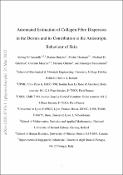Options
Automated Estimation of Collagen Fibre Dispersion in the Dermis and its Contribution to the Anisotropic Behaviour of Skin
Date Issued
2012-08
Date Available
2015-11-23T12:16:24Z
Abstract
Collagen fibres play an important role in the mechanical behaviour of many soft tissues. Modelling of such tissues now often incorporates a collagen fibre distribution. However, the availability of accurate structural data has so far lagged behind the progress of anisotropic constitutive modelling. Here, an automated process is developed to identify the orientation of collagen fibres using inexpensive and relatively simple techniques. The method uses established histological techniques and an algorithm implemented in the MATLAB image processing toolbox. It takes an average of 15 s to evaluate one image, compared to several hours if assessed visually. The technique was applied to histological sections of human skin with different Langer line orientations and a definite correlation between the orientation of Langer lines and the preferred orientation of collagen fibres in the dermis (p<0.001,R2=0.95) was observed. The structural parameters of the Gasser–Ogden–Holzapfel (GOH) model were all successfully evaluated. The mean dispersion factor for the dermis was κ=0.1404±0.0028. The constitutive parameters μ, k 1 and k 2 were evaluated through physically-based, least squares curve-fitting of experimental test data. The values found for μ, k 1 and k 2 were 0.2014 MPa, 243.6 and 0.1327, respectively. Finally, the above model was implemented in ABAQUS/Standard and a finite element (FE) computation was performed of uniaxial extension tests on human skin. It is expected that the results of this study will assist those wishing to model skin, and that the algorithm described will be of benefit to those who wish to evaluate the collagen dispersion of other soft tissues.
Sponsorship
European Commission - Seventh Framework Programme (FP7)
Irish Research Council for Science, Engineering and Technology
Other Sponsorship
Office of the State Pathologist (Irish Department of Justice and Equality)
Ilede-France region
PRIN 2009 project 'Matematica e meccanica dei sistemi biologici e dei tessuti molli'
Type of Material
Journal Article
Publisher
Springer
Journal
Annals of Biomedical Engineering
Volume
40
Issue
8
Start Page
1666
End Page
1678
Copyright (Published Version)
2012 Biomedical Engineering Society
Language
English
Status of Item
Peer reviewed
This item is made available under a Creative Commons License
File(s)
Loading...
Name
NiAnnaidh2012b.pdf
Size
4.3 MB
Format
Adobe PDF
Checksum (MD5)
edaa13355c522258463c6e07f4057c1d
Owning collection